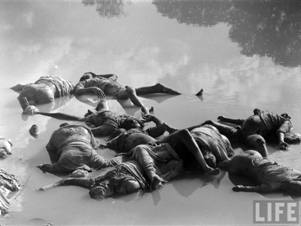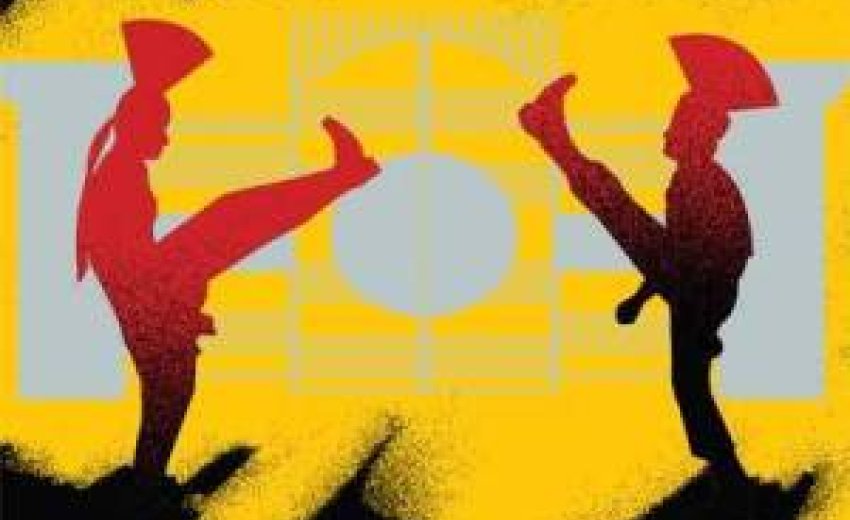|
|
August 13, 2013: BERKELEY, Calif. — Growing up, Guneeta Singh Bhalla heard a terrifying story from her grandmother. In August 1947, as British India was being partitioned into independent India and Pakistan, her grandmother fled Lahore, in what was soon to become Pakistan, for Amritsar, in what was soon to become India. All around her was carnage. Clutching her three young children, she looked out the train window to see bodies strewed along the tracks. The memory haunted her until she died.
 |
 |
 |
 |
| Pictures (some rare) of the Indian Partition 1947 |
“It’s something that’s been brewing in my mind since high school,” recalled Ms. Bhalla, a research physicist who is now 34, about the same age as her grandmother in 1947. “As I was growing up, it was always in the back of my head, and bothersome, as family members were passing.”
The partition, which carved up British India roughly along religious and political lines, uprooted over 10 million people. Hindus and Sikhs escaped to India; Muslims to Pakistan. Christians, Jews and Zoroastrians were left to choose where to live as minorities. The dead were difficult to count; estimates range from 250,000 to two million. No one knows how many were raped.
The oral history project is equally remarkable for being the first of its kind. As much as the partition hangs over the politics and psyche of the Indian subcontinent, there is no memorial — digital or analog — to mark it. This homegrown, volunteer-run project, directed from a few cubbies at the University of California here, is one of the first efforts to collect those memories. Now, because most of the partition’s witnesses are gone — most subjects are in their 70s and 80s — the project has taken on new urgency. At least 20 of the 100 people Ms. Bhalla has interviewed have died, she said. And so, with help from donors, the archive plans to dispatch 20 story gatherers this year to several cities in South Asia to collect stories while their tellers are still alive.
Many stories come from South Asians now living in the United States, though most are from those still living in India, Pakistan or Bangladesh, which was part of Pakistan until 1971. The accounts, once they start pouring out, are one to four hours long. They are told in Urdu and Punjabi, Hindi, Bengali and English.
Having spent the last two years collecting stories, the project is now planning to develop new ways to share them. Its Web site will soon feature a “story map” with migration routes, excerpts from individual accounts and a tool to help partition migrants connect online with one another.
Some of those interviewed have never told their stories before, not even
to their families. A Zoroastrian woman from Karachi recalls how her
grandmother hid her Hindu maid from family members who wanted to convert
her against her will. A Hindu man from a village near Lahore recalls
surviving the train journey to India only because a Muslim man, a
stranger, hid him in his first-class compartment; other Hindus on that
same train were killed or wounded. A Muslim man from what is now Indian
Punjab describes watching a mob stab his mother as she tried to protect her older son.
Video excerpts from a handful of interviews can be viewed on the Web
site. Streaming all of them, in their entirety, will cost more than the
project now has: about $56,000 from community donations and a grant from
the American India Foundation. Ms. Bhalla hopes that one day the stories can be housed by libraries or research centers worldwide.
|
|
| Video by 1947PartitionArchive Radhika Kishin Chehnani on her move from Hyderabad, Sindh, Pakistan to Mumbai, India. |
|
|
| Video by 1947PartitionArchive Ravi Chopra on his move from Sialkot, Punjab, Pakistan to Firozpur, Punjab, India. |
Like Ms. Bhalla, most story collectors are two generations removed; many are Americans of South Asian descent. They have fanned out to mosques and temples across the United States to solicit accounts from elders, and recorded them on hand-held video cameras and smartphones. One volunteer, Farhana Afroz, flew from Fremont, Calif., where she lives now, to several cities in Bangladesh, where she was born, to collect stories, leaving her husband and children back home.
Volunteers are sometimes asked: Who are you? Why are you doing this? Their answer: Because we must not forget. They are backed by no government, which helps. The goal is to record oral histories without judgment or analysis — or, indeed, corroboration.
Their list of questions include: When did you first hear about the partition? Did you have to defend yourself against violence?
And: Did you help drive out people from your area?
|
|
| Video by 1947PartitionArchive Abdul Jabbar on his move from Meerut, Uttar Pradesh, India to Lahore, Punjab, Pakistan. |
In California, Ms. Bhalla came upon two men — one Sikh, one Muslim — who had spent their childhoods in neighboring villages in what is now the state of Punjab in India. Ali Shan, a Muslim who fled to Pakistan, was living in Fremont, south of here. Hardev Singh Grewal, a Sikh who remained in India, was living in neighboring Union City. Ms. Bhalla asked if they wished to meet. Of course, they said.
On a rainy Saturday evening, they shared samosas and tea at the Grewal home. Mr. Shan, 72, sat stiffly at first on a white leather sofa. For the first couple of hours, they reminisced about an annual fair in Jurrahan, where Mr. Shan once lived. They remembered the names of the local schools. As the evening wore on, the more difficult stories trickled out. Mr. Shan told Mr. Grewal how a mob stabbed his mother and brother before his eyes when he was 6 — and then how a man in that mob inexplicably took him home.
Mr. Grewal, 76, inched close to him, patted him on the shoulder. Mr. Shan’s eyes filled with tears. He kept going. He remained with the stranger’s family for months, he said, and then an uncle took him to Pakistan. Mr. Grewal kept his arm on Mr. Shan’s shoulder.
Mr. Grewal recalled that the elders of his village, Gujjarwal, barely four miles from Jurrahan, had offered to save its Muslims if they converted to Sikhism. “They meant well, but looking back, I don’t think it was a good thing,” Mr. Grewal told Mr. Shan.
Nor did it save them. They were attacked as preparations were under way for the conversion ceremony. Mr. Grewal had no idea how many were killed, only that there were enough bodies to fill ox carts and a mass grave. Mr. Grewal remembered, too, that his older brother had taken home three of his school friends, all Muslims who had been injured in the attack. They stayed in the Grewal home until they were fit enough to travel to Pakistan. He has no idea what became of them.
“Ali, I want to ask you,” Mr. Grewal finally ventured, “do you get nightmares?”
Mr. Shan shook his head: “As soon as I forgave the people who killed my family, I was a new man.”
Ms. Bhalla took it all in. This year she left a postdoctoral research fellowship at the Lawrence Berkeley National Laboratory to devote herself full time to the project.
“Both survivor and citizen oral historian come away changed,” is how she put it.

